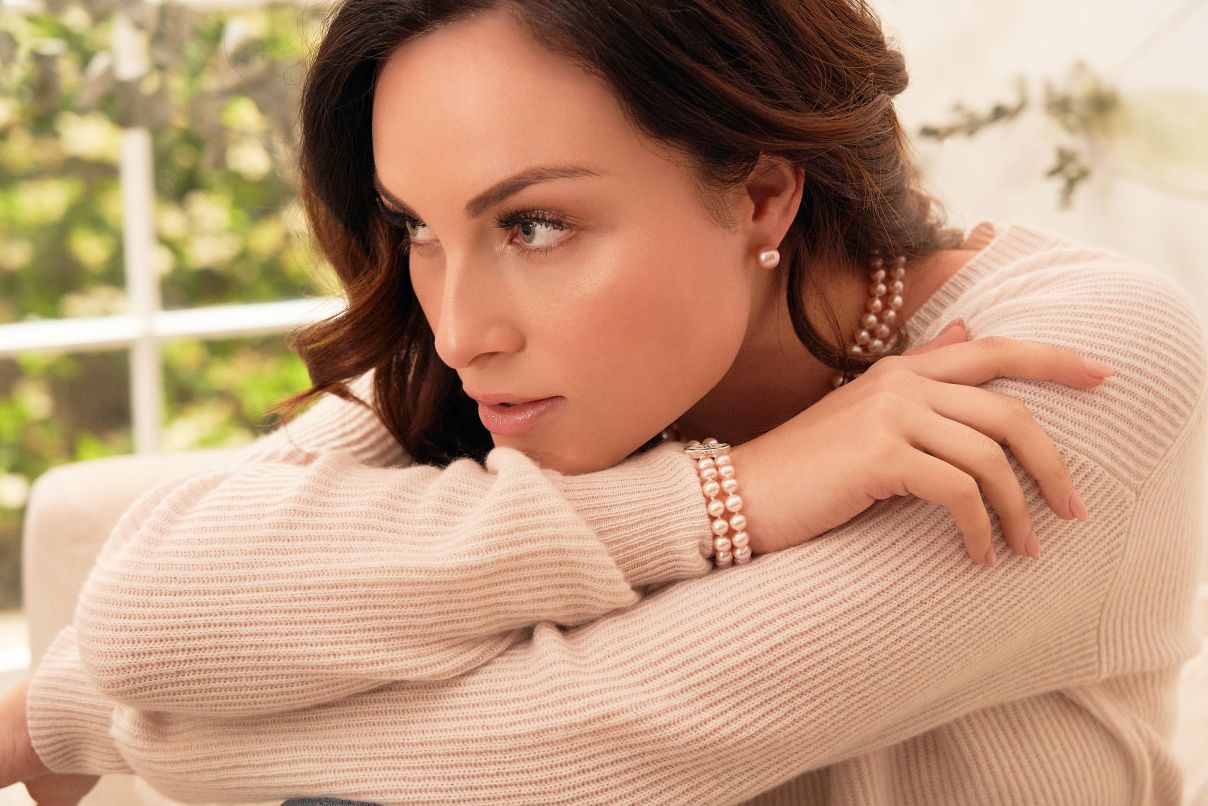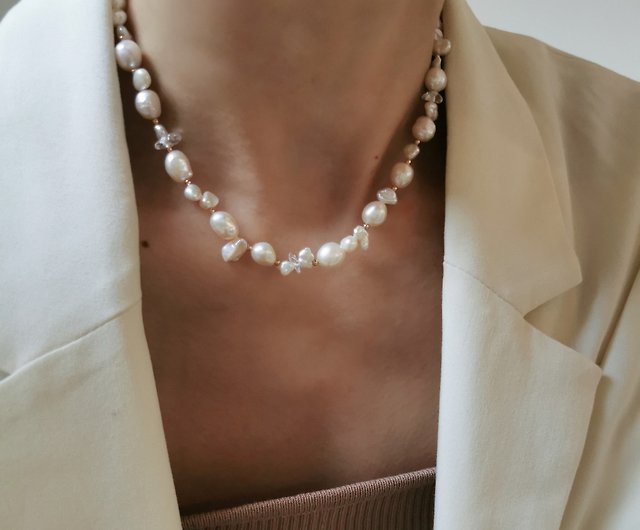If you've never purchased a pearl necklace before, the extensive selection may seem overwhelming. You may choose from a wide variety of styles, sizes, hues, and lengths. For the average student, grading is just as perplexing.
A Scale for Rating Pearl Necklaces
Where to start? How about we talk about pearl quality. You've undoubtedly seen grading schemes that seem to be all over the place if you've spent much time shopping online or in shops. Organizations may choose to publish letter grades, numeric grades, or no grades at all. This doesn't seem to make any sense at all. That's because there is a good one.Pearl Necklace With Planet Charm
The four C's of diamond grading—cut, color, carat weight, and clarity—are probably not new to you. There are seven criteria that determine how much a pearl is worth. Size, form, color, sheen, smoothness, nacre quality, and harmony are all factors. Here's the catch, though: Unlike diamonds, there is no universal system for evaluating the quality of pearls.
The implication for you is what? Simple. Comparisons cannot be made only on the basis of quality. However, the value of a pearl necklace certified AAA by one merchant may be merely a tenth of the value of a necklace classed AAA by another. Grading pearls is very subjective, with significant variation even among the world's leading pearl retailers.
Reputation is what you may use to evaluate various vendors. Google is your best buddy when it comes to internet buying. You can easily find out whether a pearl vendor is reputable and recognized for providing high-quality items at fair prices. Online reviews are abundant for reputable stores.
Pearl Paradise: A Guide to the Grading of Strand Pearls
Let's begin with the most widespread misunderstanding about purchasing a pearl necklace. Cultured pearls are what you're after. You may put your faith in me. True pearls are not what you want. A century ago, the commerce in natural pearls was supplanted by the cultivation of pearls by the induction of pearl oysters. Although delicate strands of natural pearls are still available, they may cost more than a million dollars.Pearl Necklace With Gold Planet
Akoya pearls, freshwater pearls, Tahitian pearls, and South Sea pearls are the four most prevalent types of cultivated pearls sold today. Each one provides a unique experience and has the potential to be very beautiful.
Necklaces Set with Authentic Akoya Pearls
Today's market is saturated with cultivated pearls of four different types: akoya, freshwater, Tahitian, and South Sea. Each one provides a unique experience and has the potential to be very beautiful. Pearl Necklace With A Planet
Akoya pearls are highly prized for their exceptional brightness, which sets them apart from other types of pearls. The luster of a pearl refers to the amount and quality of light reflected by its surface. If you're looking for an akoya pearl necklace, this is the most crucial consideration. To put it another way, it's the secret to the pearls' luster. Furthermore, it is undeniable evidence that the pearls were properly nurtured by their mother oyster. Remember what I said regarding a seller's credibility, by any chance?
It takes around two years for an Akoya pearl to form once an oyster has been seeded with a perfectly spherical bead and then returned to the ocean. While some farmers take their time, many others harvest in a few of months. Even if the pearls have a similar appearance at first, they won't endure more than a few years.
Experts use the term "hanadama" to refer to the highest quality akoya pearls. Wait! So, does this imply you may shop around for the best deal on hanadama-quality pearls? Unfortunately, that's not the case. Even when evaluated in a laboratory, there is still considerable room for interpretation and variation. Again, this boils down to a matter of standing.
This aside on akoya pearls is important to add. While most akoya are standard white and perfectly spherical, some may be found in unusual natural colors including blue, silver-blue, gold, and even baroque. You'd have a hard time locating one of them in a jewelry shop because of how uncommon they are.
7-7.5 mm akoya pearl necklaces are the most popular, with 8-8.5 mm coming in at a close second. I wouldn't recommend getting anything too little unless you're buying a strand for a young girl.
Examine Our Assortment of Akoya Pearl Pendants
Necklaces Set with Natural, Freshwater Pearls
Even though they are more "pearl" than akoya, freshwater pearls have never been deemed quite as precious. How so? Typically, a bead is not used in the cultivation of freshwater pearls. To put it simply, they are all nacre (pearl). How come we place less value on them? A freshwater shell has the potential to produce several pearls at once. Most akoya oysters only grow one or two at a time.
If you've ever seen freshwater pearls in a shop, you may get the impression that they come in odd forms and lack luster. This is usually the situation. Lacking a central bead, they are less perfectly spherical than akoya. On the other hand, high-quality freshwater pearls do occur. Some of the best, which we call "freshadama," are almost identical to high-quality akoya pearls in terms of their appearance.
Choose freshwater pearls if this is your first time buying them or if you're buying them as a gift for someone else. Furthermore, they often develop in naturally pastel hues, giving you the akoya appearance without the hefty price tag. Only freshwater pearls come in such hues. Pearl Necklace Planet Guide
The value of freshwater pearls increases dramatically when they are sorted by size, and the standard practice is to do so in increments of half a millimeter. Our most popular size range for pearls is 7.5-8 mm, and if you were to compare a strand of 7-8 mm pearls to one of these, you would note that the 7.5-8 mm pearls are bigger, shinier, and rounder.
Visit Our Freshwater Pearl Necklace Gallery
Charming Tahitian Pearl Necklaces
Have you ever visited the French Polynesian island of Tahiti? If so, you'll probably agree that it's one of the most unusual places to have a holiday. Pearls harvested from the seas in that region are just as unusual. Although they have a reputation for being black because of their lack of iridescence, Tahitian pearls really display a wide range of hues. Light green is second most common, while dark green is third.
Tahitian pearls are my favorite kind of pearls. My travels have taken me to some of French Polynesia's most isolated islands. As part of one excursion, I took a film team to a pearl farm and produced a 20-minute documentary there. That doc won first prize at the International Family Film Festival.
I'm sure you can find twenty minutes to view this if you're thinking about buying a Tahitian pearl necklace. After completing this course, you will have more knowledge about Tahitian pearls than 99 percent of GIA-trained jewelers.
Check Out Our Assortment of Tahitian Pearl Necklaces
Necklaces Set with South Sea Pearls
If you're in the market for a South Sea pearl necklace, I imagine you're already familiar with pearls and shopping for them. My standard disclaimer for a first pearl necklace is that South Sea pearls are not the way to go. Except if you're the sort who always goes first.
The South Sea pearl is the biggest and most expensive of all cultured pearls. Grown in isolated regions of Australia, the Philippines, Indonesia, and a few others. The pearl oyster utilized in commercial production is the biggest of its kind. It's about the size of a typical dinner plate in the United States. They're about the size of marbles, these pearls.
Silver-lip and gold-lip pearl oysters are used to cultivate the respective silver- and gold-lip South Sea pearls, respectively. Yes, you guessed correctly. The former produces white and silver South Sea pearls, whilst the latter produces the rare and very precious gold South Sea pearl. They produce some of the most exquisite and expensive South Sea pearl necklaces in the world.
These pearls will make a statement. When you put it on, you're making a statement. One's own personal remark might be made by the donor. Putting on a string of South Sea pearls guarantees that you will be the center of attention.
Have a Look at Our Assortment of South Sea Pearl Necklaces
Pearl Tie-Dyeing
A pearl necklace should (almost) always include a knot between each pearl. Consider this a vital piece of information. The knots preserve the value of your purchase by preventing the pearls from scratching or rubbing against one another. Your pearls will stay together even if your necklace breaks. Small, graded strands are the only ones that can be knotted. Knots in these are often avoided or simply placed around the clasp because to their unattractive appearance.
Although many manufacturers still utilize silk, synthetic fibers are increasingly being used because they are more resilient. Whatever works for you is OK with us.
Decide Which Pearl Size Is Best for You
And I know this is a question you've been wondering about, especially if you're new to pearls. What pearl size would look best on me/her? What would the difference be between an 8 mm strand of freshadama and a 6 mm strand of akoya? Where do they stand in comparison to a string of 10 mm Tahitian pearls?
We've been dealing in pearls for two decades. I'm able to firmly state the most sought-after dimensions. To be on the safe side, stick to these measurements. Not too large, not too tiny; just right. A smaller size is the way to go if that's what you're after. You should seek for something much bigger if that's what you're want.
The most sought-after akoya pearls are 7-7.5 mm in diameter. 8-8.5 mm comes in as a close second.
7.5-8 mm freshwater pearl necklaces are the most popular size. The 8.5-9 mm range is the second most common.
Larger pearls are characteristic of Tahitian pearl necklaces. The pearls on a strand gradually become bigger as they go farther from the clasp. Every year, we bring in thousands of Tahitian pearls, the vast majority of which are 8-11 mm in size. That says something.
The biggest pearls are found in the South Sea. Large pearls are what you're looking for in a South Sea pearl necklace. The most popular and the most wearing size spans from 10 to 14 mm.
Keep this piece of information in mind if you're looking for a necklace that's either smaller or bigger than these. The diameter of a pearl is measured in millimeters along its axis, or the area between its drill holes. A difference of a few millimeters may not seem like much, but when you consider the volume involved, you'll realize just how much of a difference it is.
Optimal Length Selection
The length of a pearl necklace is a personal decision. How would you describe the style you're looking for? Generally speaking, a shorter string of pearls is more appropriate for everyday use. The general guideline is that longer strands are more formal.
Sixteen and eighteen inches are the most often purchased sizes. Longer strands, up to 35 inches or even 50 inches, are also often worn due of their versatility.



Comments
Post a Comment